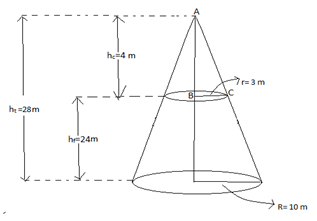A tent is made in the form of a frustum of a cone surmounted by another cone. The diameter of the base and the top of the frustum are 20 m and 6 m respectively, and the height is 24 m. If the height of the tent is 28 m and the radius of the conical part is equal to the radius of the top of the frustum, find the quantity of canvas required. [Take π = 22/7.]

Given: Diameter of base of frustum = 20 m
Diameter of top of frustum = 6 m
∴ Radius of base = R = 20/2 = 10 m
∴ Radius of top = r = 6/2 = 3 m
Height of frustum = hf = 24 m
Height of tent = ht = 28 m
∴ height of cone = hc = ht -hf = 28-24 = 4 m
Formula: Total surface area of frustum = πr2 + πR2 + π(R + r)lf m2
Total surface area of cone = πrlc
Where lf = slant height of frustum & lc = slant height of cone
![]()
![]()
∴ lf = 25 m
For slant height of cone consider right angled ΔABC from figure
AB = hc = 4 m ; BC = r = 3 m ; AC = lc
By pythagoras theorm
AB2 + BC2 = AC2
∴ 42 + 32 = lc2
∴ lc = ![]() 5
5
Since length cannot be negative lc = 5 m
Since for tent we don’t require the upper circle of frustum and the lower circle of frustum hence we should subtract their area as we don’t require canvas for that.
Surface area of upper circle = πr2
Surface area of lower circle = πR2
∴ Surface area of frustum for which canvas is required = πr2 + πR2 + π(R + r)lf - πr2-πR2cm2
= π(R + r)lfm2
= (22/7) × (10 + 3) × 25 m2
= (22/7) × 325 m2
= 1021.4285 m2
Surface area of cone = πrlc m2
= (22/7) × 3 × 5 m2
= (22/7) × 15 m2
= 47.1428 m2
∴ Quantity of canvas required = surface area of frustum + surface area of cone
= 1021.4285 + 47.1428 m2
= 1068.5713 m2
∴ Quantity of canvas required = 1068.5713 m2